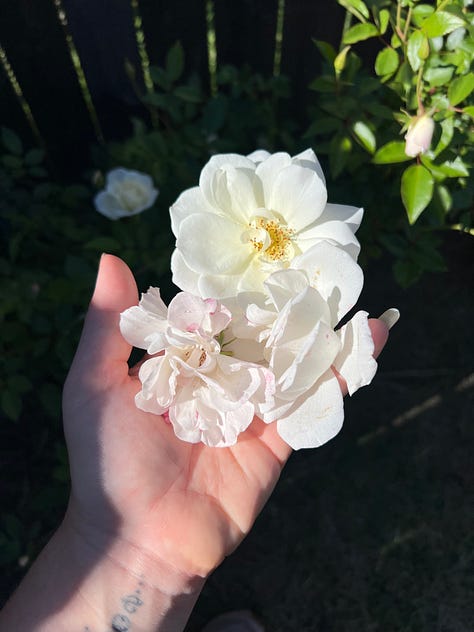
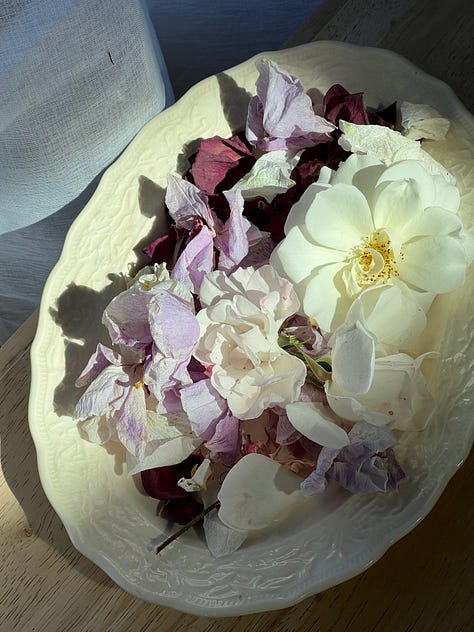
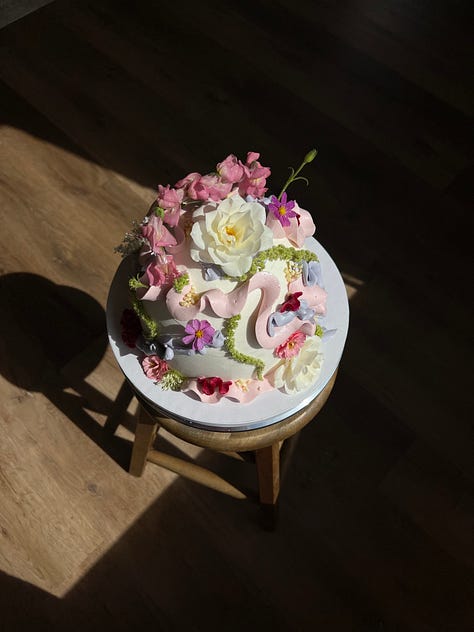
Hello Loves,
As I was bare foot in my garden this morning, clipping my first blooms of the season. I paused for a moment of gratitude.. its been over a year since stewarding a garden (I moved houses last summer so I had to pause on this little hobby of mine) But after some grit and hard work, the beginnings of new garden chapter has begun.
I am so moved by growing flowers, it truly is something so magical to me. Nurturing a relationship with a plant that gives you so much beauty just is simply one of life’s greatest joys.
Across all social media platforms I use (TT, Substack, and beloved Instagram) the number one question I get asked DAILY is, “How do you know what flowers to use”
As I was sprucing up the corners of my home this morning with fresh flowers from my garden I thought I’d share a simple guide to flowers to use for food consumption and also some that aren’t edible but safe to place on cakes. I’ll share my most favorite first and then at the end i’ll mention some flower that I see used on cakes that I wish more people knew not to use.
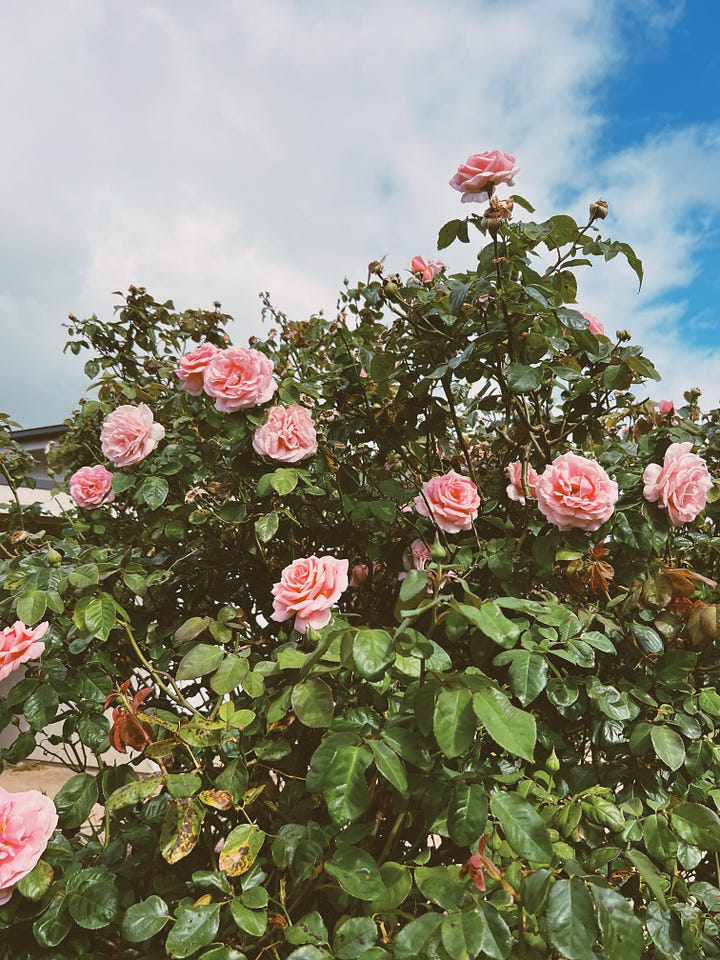
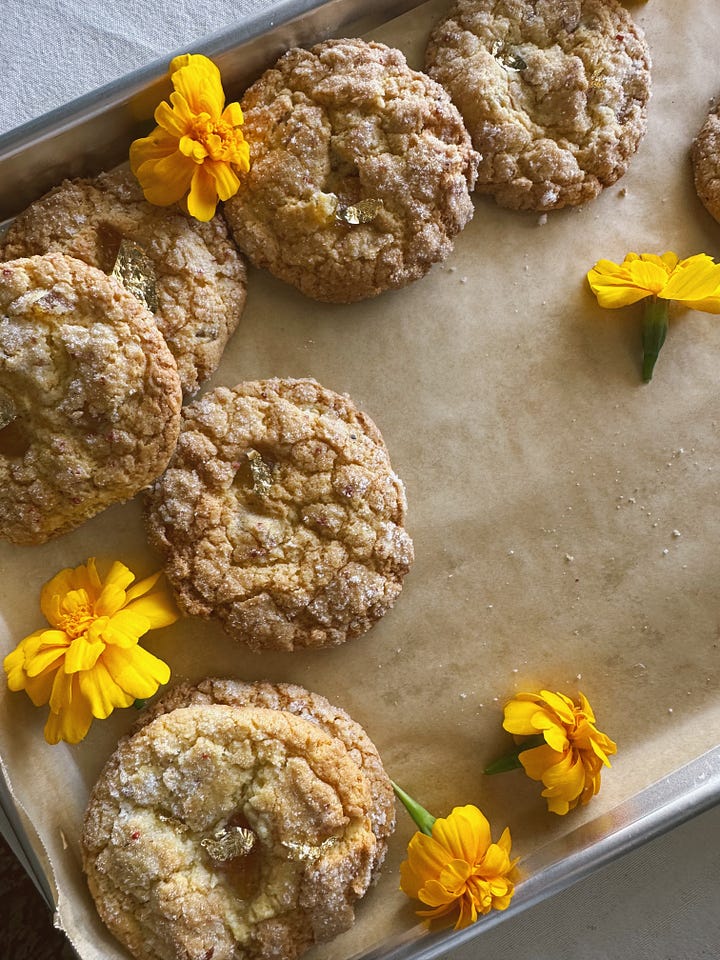
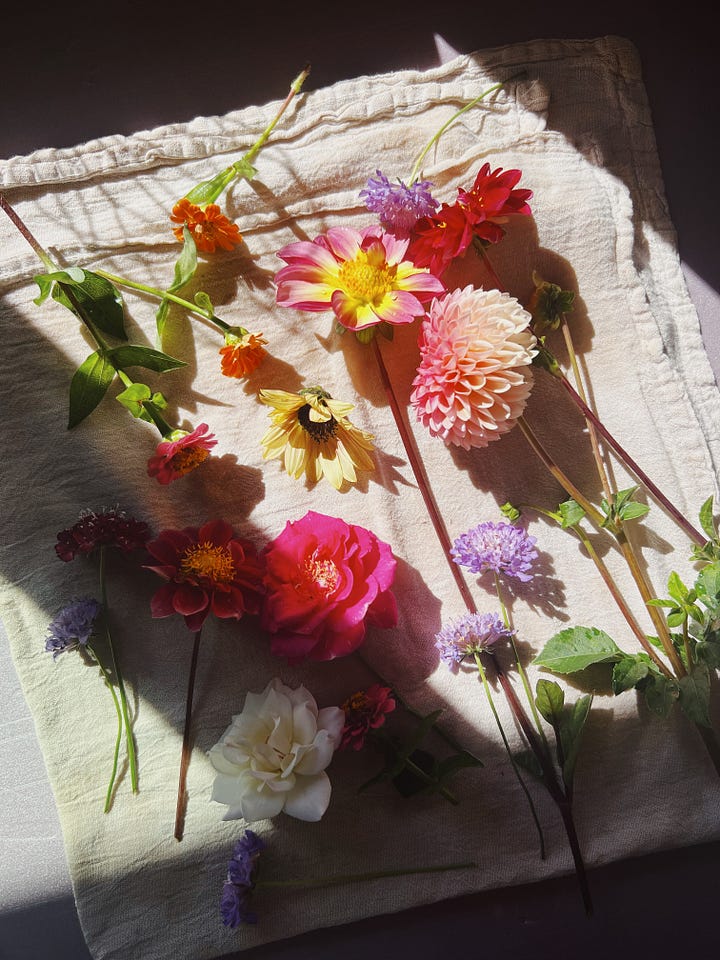
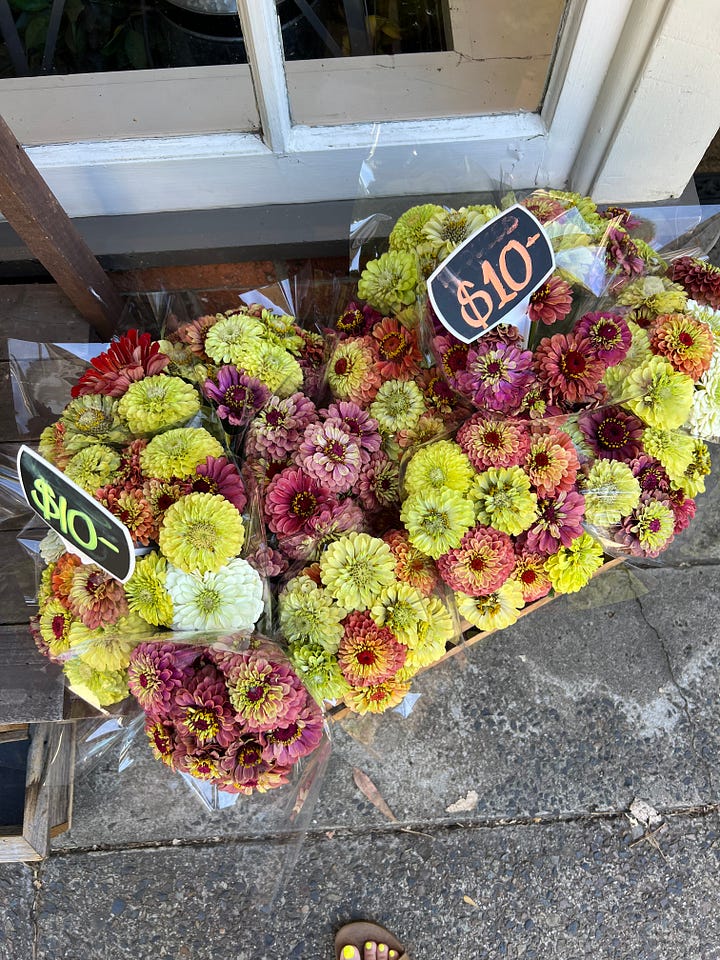
#1 Roses
Beloved roses.. I have such a strong connection to these flowers, I see myself in the future being a strong steward of these incredible blooms. They are edible!! In fact they are used widely as a herbal remedy for grief, soothing, heart-opening qualities. With natural anti-inflammatory properties and a gentle, cooling energy, roses calm both the skin and the spirit. Traditionally used to ease grief, support digestion, and tone the skin, they also carry a quiet power as a mild aphrodisiac and emotional balm. Whether sipped as tea or scattered over cake, roses bring both beauty and balance, offering more than flavor—they offer feeling. Be sure to grow them organically, or source locally grown by farmers using safe practices. Roses are one of the more poetic ones to use on cake composition too.. dried or slightly wilted offer texture and movement to a cake, petals break up Blank space, or the frills offer something unique to the eye.
#2 Dahlias
I’ve been gifted a few years of growing dahlias from both tubers and seed, and I must say.. These are my second fav flower to use. They are also edible, but posses a stronger flavor to a rose- Dahlia petals have a mild, crisp flavor that can vary depending on the variety—but they’re generally slightly sweet, with a fresh, lettuce-like or slightly spicy undertone.
The gift of these flowers when used on cakes are the incredible variety- no plant is ever really the same, they come in all shapes, sizes + colors. Some varieties I love are the dinner plate sizes, Café au Lait, Emory Paul, Kevin floodlight.. Dahlias grown from tubers are true to what they are- but dahlias grown from seed are a completely new variety, so new flowers are being born yearly thanks to the cross pollination of our beloved bee’s. Some varieties I find difficult to use, the round ball like ones don’t offer a lot of fluidity on a cake, sometimes placing one on a cake can be quiet abrupt- so play with ones that offer more movement and shape.
#3 Pansies
Pansies are small, velvety blooms known for their vivid, painterly petals and distinct “faces”—a dark blotch at the flower’s center that gives them a curious, expressive look. Their overlapping, heart-shaped petals come in rich shades of purple, yellow, blue, and white, often with soft watercolor-like gradients. Despite their delicate size, they bring a bold visual charm to cakes, like tiny floral portraits or butterflies at rest, making them both edible and enchanting- and they are edible, not only just perfect for cakes, they can be made into tea, or sprinkled in salads
#4 Cosmos
Cosmos flowers have a wild, airy elegance, with delicate, daisy-like petals that radiate from a golden center like rays of sunshine. Their blooms float atop tall, slender stems and feathery, fern-like foliage, giving them a light, ethereal presence—almost as if they’re dancing in the breeze. I LOVE cosmos, but note.. they don’t last long on a cake, so when it comes to decorating it’s always good to pop them on before the cake is handed off to the client. I don’t use them much in wedding cakes (although that makes me sad) because wedding cakes don’t typically get served straight away. But the reason I love them Is because of their whimsical airy elegance on a cake.. they add a certain lightness/movement and texture to a cake composition. They are another great edible option
#5 Marigolds + Calendulas
Cute bright bursts of sunshine, in yellow, orange and red. I love using the flowers in the center, they look like fairy flowers, and often I use them in tiny leis for the cake.
Often used in salves and creams, they help soothe minor wounds, burns, rashes, and irritations while promoting faster healing. Their antibacterial nature makes them effective for treating skin infections and sore throats, and their gentle digestive properties can ease upset stomachs and gastritis. Rich in antioxidants, marigolds also support the immune system and are sometimes used to relieve menstrual cramps. With their versatile healing qualities, marigolds offer both topical and internal benefits. They are small and offer great option for cake decorating, especially the petals
#6 Zinnias
Zinnias are vibrant, bold blooms with a daisy-like shape and a variety of colors ranging from fiery reds and oranges to soft pinks and purples. Their petals are slightly sweet with a mild, peppery undertone, making them an excellent addition to salads, cakes, or cocktails for a pop of color and a hint of flavor. While visually striking, zinnias are more about texturethan flavor, offering a crisp, refreshing bite that pairs well with fresh herbs or citrus. Edible and often used as a garnish, they bring both beauty and a subtle, pleasant taste to dishes. I find zinnias also a bit abrupt to use on cakes- their round shape doesn’t offer a lot of movement BUT I’ve seen them be used in great ways- removing 3-4 petals and scattering them close by offers a story, not just a flower on a cake. examples below-
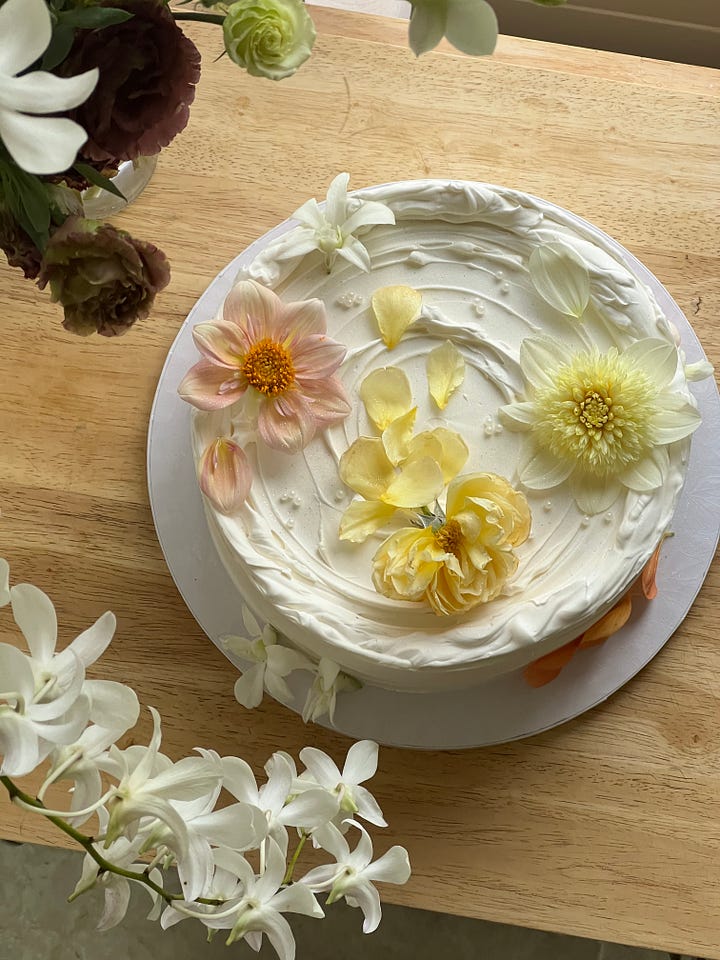
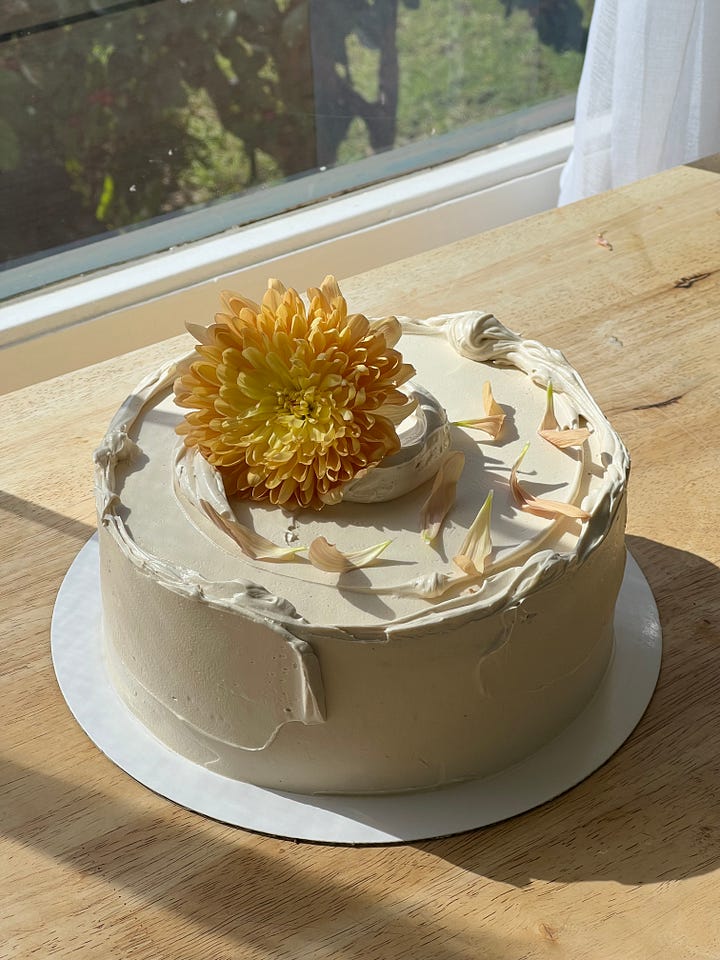
#7 Sunflowers
Sunflowers are bold, sun-seeking blooms with bright golden petals and a commanding presence, often symbolizing joy and vitality. While their seeds are the most commonly eaten part—nutty, rich, and protein-packed—the petals themselves are also edible, offering a slightly bitter, grassy flavor similar to young greens.
I love using small sunflowers, the big ones can definitely over take a whole cake- but the petals are something else to be considered on your cake decorating journey- offering bright colors and interesting shapes.
#8 Snapdragons
Snapdragons are whimsical, spire-like flowers with dragon-shaped blooms that open and close when gently squeezed—hence their name. I love using snaps, the whole stem or plucking off the individual flowers offer so much texture and movement with a cake. With bold colors ranging from pastels to deep jewel tones, they add vertical elegance and a touch of fantasy to cake designs. Edible but more often used for decoration, snapdragons have a mildly bitter, earthy flavor, sometimes described as peppery or slightly medicinal. They're not the most flavorful bloom, but their dramatic shape and range of hues make them a striking, textural garnish for cakes, especially when you want a balance of structure and softness.
Here’s a list of others I like to use-
Chamomile- whimsical, dainty, offer lots of movement- another edible joy
Celosia - comes in all different shapes and sizes, but TEXTURE is its thing, often looking like coral or whispy grass like flowers - I would eat this one- its safe, just not pleasant to eat.
Amaranth- Long trailing tentacles of dramatic, eye-catching plant- cascading tassels of deep magenta or crimson and green flowers that drape like velvet ropes from tall, upright stems. Its look is both romantic and wild- although can be eaten, not pleasant. MY FAV to work with..
Orchids- Orchids are the epitome of exotic elegance—sculptural, symmetrical blooms that almost seem too perfect to be real. With their intricate shapes, velvety petals, and a palette that ranges from soft pastels to vivid jewel tones, orchids evoke luxury, mystery, and delicate beauty. In the edible world, certain varieties like Dendrobium and Phalaenopsis are safe to consume and often used as stunning, flavorful garnishes. Their taste is light, slightly floral, and cucumber-like, adding subtle freshness rather than bold flavor. On cakes, they serve more as edible art than culinary centerpiece—each bloom a graceful, living sculpture.
Strawflower- Strawflowers are charming, papery blooms that look like they’ve been dried by nature while still on the stem. Their stiff, rustling petals come in vibrant shades of orange, pink, yellow, and white, often with a golden center, and they retain their shape and color long after picking—making them a favorite for everlasting cake décor- these are great flowers if you have customer picking up a cake early or the day before, you know that they will still look the same the next day!
Bachelor Buttons- Bachelor’s buttons are charming, daisy-like blooms with spiky, ruffled petals in rich hues of cobalt blue, lavender, pink, and white. Their texture is light and papery, adding a soft, whimsical touch to cakes
Other edible fun things to use-
Coriander flowers, thyme, parsley, queens annes lace, fennel, butterfly pea flowers + nasturtiums, gladiolas, stock, strawberry flowers, lemon blossom, limes blossoms, lemon verbena, mint, corn flowers,
Books I recommend for getting to know flowers a little more-
The art of edible flowers by Rebecca Sullivan
Edible Flower Garden by Rosalind Creasy
Another wonderful grading resource is Erin with Floret flower, I suggest her flower farm guide (where she shares where to buy the best seeds- her docu series on HBO is a must watch
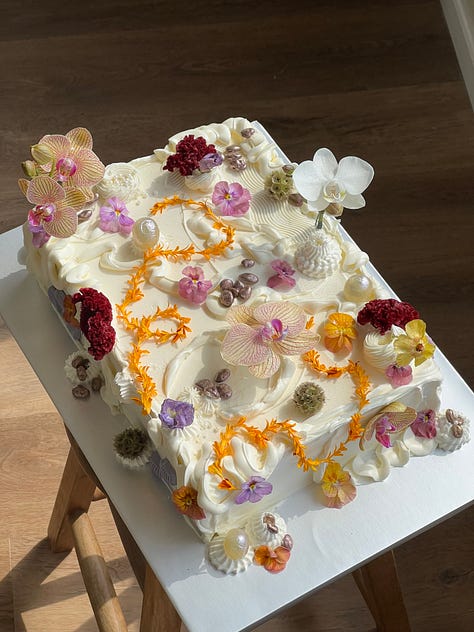
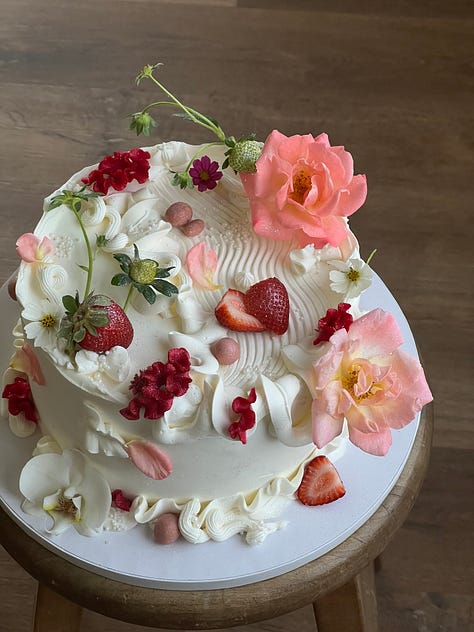
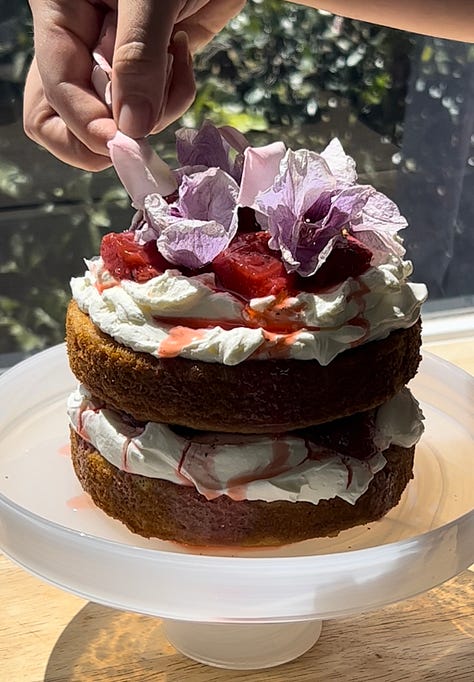
Things to watch out for-
I see often cake makers using these flowers and although undeniably beautiful, flowers like sweet peas, daffodils, oleander, hydrangea, and larkspur are all toxic and should never be used on cakes or near food. Sweet peas, despite their charming name and fragrance, contain toxins harmful to both humans and pets. Daffodils have compounds that can cause nausea, vomiting, and more severe symptoms if ingested. Oleander is one of the most poisonous ornamental plants—every part is dangerous. Hydrangeas contain cyanogenic glycosides, which can release cyanide when consumed. And larkspur, with its striking spires of color, is highly toxic and potentially deadly. These flowers are best admired in the garden, not on your cake!
I know some bakers are using precautionary practises- if I am to use something that is mildly poisonous like ranunculus I wrap my stems in florist tape (well wrapped) or I use a florist water pick here’s the ones I use
Even if you're not planning to eat the flower, placing mildly toxic flowers directly on cakes is risky—their sap or pollen can contaminate the frosting. Always use floral picks, wrap stems in floral tape, or place a barrier (like parchment or wax paper) between the flower and the cake.
Okay, I could really go on and on, but this may be a part one, I will indeed go into depth as time goes on- in the mean time, please don’t hesitate to leave a comment or reach out with questions.
I hope this inspires you to grow some flowers, or at least play in the kitchen with some edible varieties.

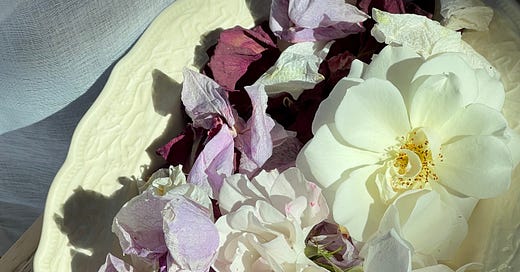



This is Magic and so informative, Nadine! Thank you so so much for teaching me!! I can’t wait to continue to learn. I agree about the HBO Floret doc being a must watch. I found it this winter… it was divine nectar for January. I would LOVE to watch an HBO doc about your work! A share in case you ever were curious. 😁 Much gratitude, flowers, and love your way, Katy 🩷🌹💛
Super handy post!